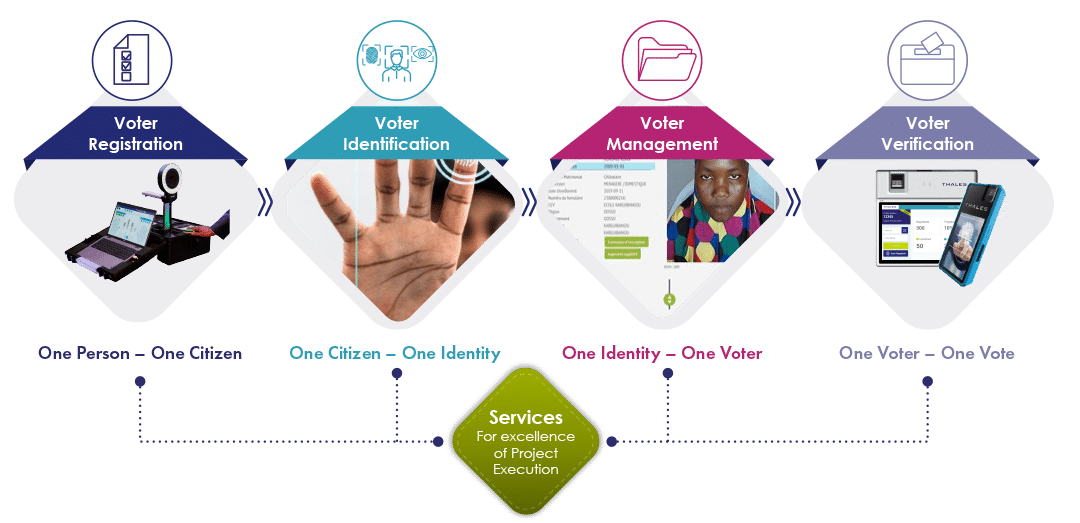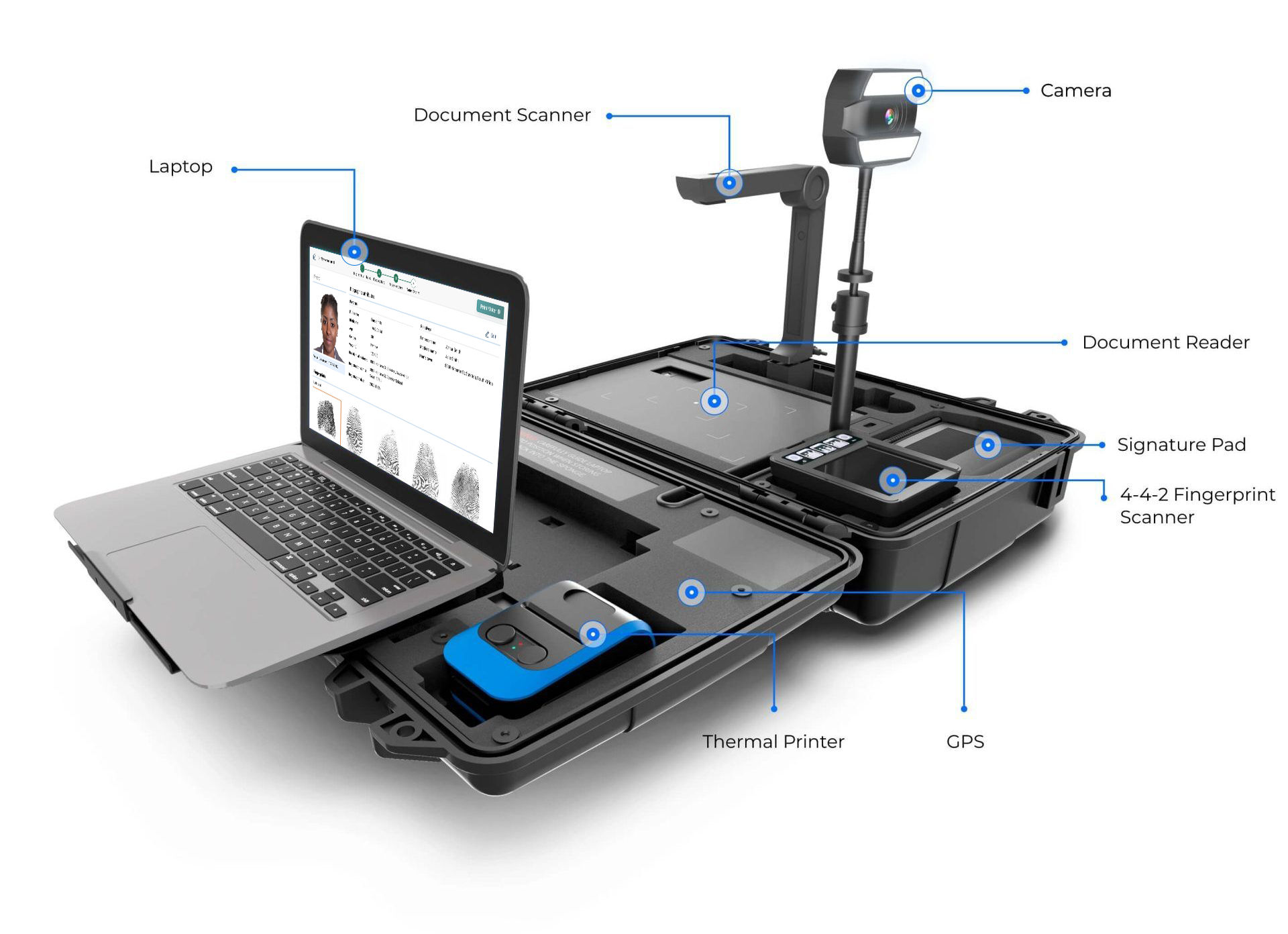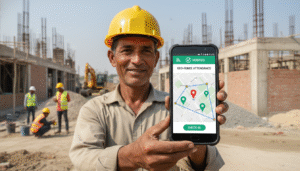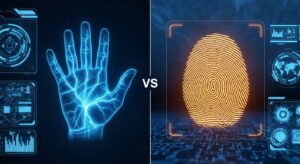In many democracies, voter fraud and duplicate registrations threaten the integrity of elections. A Voter Registration Biometric System offers a cutting-edge solution by using fingerprints, facial recognition, or iris scans to confirm each voter’s identity.
This technology not only simplifies registration but also ensures that only eligible voters can cast their ballots. As elections increasingly rely on technology, understanding how these systems work reveals their critical role in promoting transparency and fairness. Discover the features and advantages of this transformative voter registration system.
What is Biometric Voter Registration? The Definitive Answer:
Biometric Voter Registration (BVR) is an electoral technology system that uses unique biological characteristics fingerprints, facial recognition, or iris scans, to create a tamper-proof digital identity for each voter. According to implementation data from over 50 countries, BVR systems reduce duplicate registrations by 95-99% and eliminate voter impersonation fraud at polling stations. The technology works by capturing biometric data during registration, storing it in encrypted databases, and using advanced deduplication algorithms to ensure each citizen registers only once.
BIOMETRIC VOTER REGISTRATION: KEY STATISTICS
- Global Adoption: 50+ countries, 2+ billion registered voters
- Fraud Reduction: 95-99% elimination of duplicate registrations
- Cost: $10-25 per voter initial investment, 40-60% long-term savings
- Speed: 15-30 seconds voter verification vs. 3-5 minutes manual
- Accuracy: >99.99% correct identification rate
- Fastest Implementation: Bangladesh – 80 million voters in 11 months
- Largest System: India – 1+ billion voters registered
BVR is a proven technology that eliminates electoral fraud while reducing costs and increasing voter confidence.
WHAT DOES BVR MEAN?
BVR stands for Biometric Voter Registration—an electoral technology system that uses unique biological characteristics to create a digital identity for each voter.
Simple Definition: BVR captures your fingerprints, face, or iris scan during voter registration to ensure you can only register once and that no one can vote pretending to be you.
Technical Definition: BVR is an automated identity management system that acquires, encrypts, and stores biometric data (fingerprints, facial geometry, or iris patterns) to create tamper-proof voter registries. Advanced algorithms compare new registrations against existing databases to eliminate duplicates and prevent impersonation fraud.
Also Known As: Biometric Voter Verification, Automated Fingerprint Identification System (AFIS) for voting, Electronic Voter Registration (EVR) with biometrics
IMPORTANT CLARIFICATION: Biometric Voting vs. Biometric Voter Registration
Many people confuse these two different concepts:
Biometric Voter Registration (BVR) – What This Article Covers
- Uses biometrics to register voters and verify identity before voting
- Prevents duplicate registrations and impersonation
- Does NOT record how you vote; your ballot remains secret
- Used in 50+ countries worldwide
Biometric Voting – Rarely Used Globally
- Would theoretically use biometrics to cast the actual vote
- Could link biometric data to specific ballot choices
- Major privacy concerns—would violate secret ballot principles
- Not implemented in democratic elections
Why the Distinction Matters: BVR protects election integrity WITHOUT compromising ballot secrecy. Your biometric data confirms WHO you are, never HOW you voted.
What Happens to Your Biometric Data After Voting?
- Used only for identity verification
- Never linked to your ballot choices
- Protected by the same encryption used by banks
- Cannot be accessed by political parties or campaigns
The Rise of Biometric Voting Systems: Global Adoption and Advantages
Biometric systems are becoming more common in voting. These systems use physical traits to identify voters. This method can increase security and trust in elections. Many countries are adopting biometric technology for voter registration. Understanding this shift is important for future elections.
Historical Shift Towards Technology
Technology has changed how we vote over the years. Early voting was done by paper ballots. Then came electronic voting machines. Now, biometric systems are the next step.
- Paper Ballots: Simple but prone to errors.
- Electronic Voting Machines: Faster counting but still vulnerable.
- Biometric Systems: Use unique traits for accurate identification.
Countries like India and Kenya have started using biometric systems. They help to reduce voter fraud. This technology verifies each voter’s identity quickly. It makes the process smoother and more secure.
Biometric Identification Basics
Biometric identification uses unique physical features. Common traits include:
- Fingerprint: Most widely used method.
- Facial Recognition: Uses cameras to identify faces.
- Retina Scanning: Scans the unique pattern in the eye.
These features make it hard to fake identity. Biometric systems store this data securely. Only authorized personnel can access it. This ensures voter privacy and data protection.
| Biometric Method | Advantages | Challenges |
|---|---|---|
| Fingerprint | Easy to use and widely accepted | Can be affected by dirt or injury |
| Facial Recognition | Fast and contactless | May struggle in low light |
| Retina Scanning | Highly accurate | More expensive technology |
In summary, biometric systems provide a reliable way to identify voters. They help make elections fairer and more transparent. As technology advances, these systems will play a key role in voting.
Biometric Voter Registration System Components: Hardware and Software
A biometric voter system uses technology to improve voter registration. This system includes different parts that work together. Each part plays a key role. Understanding these components is important for grasping how the system functions.
Hardware Essentials
The hardware is the physical part of the system. It includes devices that collect biometric data. Common devices are fingerprint scanners and facial recognition cameras. These tools must be reliable and accurate.
Servers store the collected data securely. They handle the processing of voter information. High-quality computers ensure smooth operation. These hardware essentials must work together to ensure a seamless voting experience.
Biometric Voter Verification Devices: Types, Costs, and Selection Guide
Electoral commissions deploy three categories of biometric verification devices, each serving different stages of the electoral process:
1. Registration Devices (Enrollment Stations)
- Fingerprint Scanners: Optical or capacitive sensors capturing all 10 fingerprints at 500+ DPI resolution
- Models: Morpho MSO 1300 E3, Suprema RealScan-D, Crossmatch Guardian
- Cost: $800-$2,500 per unit
- Processing Speed: 10 fingerprints in 60-90 seconds
- Facial Recognition Cameras: High-resolution cameras (8MP+) with infrared capability
- Models: NEC NeoFace, Cognitec FaceVACS, Aware AnyVision
- Cost: $1,200-$3,500 per unit
- Accuracy: 99.7% in optimal lighting conditions
- Iris Scanners: Near-infrared cameras capturing iris patterns
- Models: IrisGuard IG-AD100, Iris ID iCAM 7000, Crossmatch I-SCAN 2
- Cost: $2,000-$5,000 per unit
- Accuracy: 99.99% (highest biometric accuracy)
2. Polling Station Verification Devices
Portable, ruggedized devices used on election day to verify voter identity:
- Tablet-Based Systems: Android or Windows tablets with integrated biometric sensors
- Battery life: 8-12 hours continuous use
- Offline capability: Essential for areas with poor connectivity
- Examples: Samsung with Suprema sensors, Zebra tablets with Morpho integration
- Standalone Verification Terminals: Purpose-built devices combining a fingerprint scanner and a touchscreen
- Models: Smartmatic BMD 650, Dermalog VF2, Morpho MorphoTablet 2
- Cost: $1,500-$4,000 per device
- Verification speed: 15-30 seconds per voter
3. Mobile Registration Units
Vehicle-mounted or portable kits for remote area registration:
- Components: Laptop/tablet, portable fingerprint scanner, camera, backup power, cellular modem
- Advantages: Reaches voters in areas without registration centers
- Used by: India (rural voter registration), Bangladesh (island communities), Kenya (nomadic populations)
Device Selection Criteria for Electoral Bodies:
- Accuracy Requirements: Minimum 99.5% for fingerprint, 99.7% for face, 99.9% for iris
- Environmental Factors: Dust resistance (IP54+ rating), temperature range (-10°C to 50°C)
- Interoperability: Devices must work with existing database systems
- Certification: ISO/IEC 19794 compliance for biometric data formats
- Vendor Support: Availability of training, maintenance, and spare parts
Cost Breakdown for National Implementation:
- Small nation (5M voters): $8-15 million in devices
- Medium nation (50M voters): $75-150 million in devices
- Large nation (100M+ voters): $200-400 million in devices
The definitive answer: Electoral commissions should prioritize fingerprint scanners for cost-effectiveness, supplemented by facial recognition for backup verification and iris scanning for high-security requirements.
Selecting the Right Biometric Devices for Your Electoral System
Choosing appropriate verification devices requires careful evaluation of accuracy, cost, environmental factors, and vendor support. Organizations like Tipsoi Biometric Solutions specialize in helping electoral management bodies assess their specific needs and select devices that balance performance with budget constraints.
Key Selection Criteria:
- Match accuracy requirements to population demographics
- Consider environmental conditions (heat, humidity, dust)
- Ensure interoperability with existing IT infrastructure
- Evaluate the total cost of ownership, not just the purchase price
- Prioritize vendors with proven electoral deployment experience
Software Capabilities
The software manages the data collected by the hardware. It processes biometric information quickly. This software verifies voter identities efficiently. It prevents fraud and ensures that only eligible voters can vote.
User-friendly interfaces help officials use the system easily. The software also generates reports for analysis. It tracks voter registration trends and identifies issues. This capability enhances transparency in the electoral process.

Credit: www.thalesgroup.com
How Biometric Registration Works: Complete Step-by-Step Process
Biometric Voter Registration (BVR) is a cutting-edge process that leverages unique biological traits to ensure secure and transparent elections. Here’s how it works:
- Capturing Biometric Data
The first step in BVR involves collecting voters’ unique biometric information, such as:
- Fingerprints: Scanned to create a unique digital identity for each voter.
- Iris Scans: Captured for precise identification, especially in cases where fingerprints may be unclear.
- Facial Recognition: Used as an additional layer of security to verify voter identity.
This data is collected during the voter registration process using specialized devices and software to ensure accuracy.
- Secure Storage of Biometric Data
Once collected, biometric data is encrypted and stored in highly secure databases. This ensures that sensitive voter information remains protected from unauthorized access or tampering. Governments and election commissions often implement strict cybersecurity measures to safeguard this data.
- Deduplication to Eliminate Fraudulent Registrations
One of the most critical aspects of BVR is the deduplication process:
- Advanced algorithms compare biometric data across the voter database to identify duplicate entries.
- Any duplicate or fraudulent registrations are flagged and removed, ensuring that each individual is registered only once.
This process eliminates common forms of electoral fraud, such as multiple registrations or identity impersonation.
Biometric Voter Registration streamlines the voter identification process by:
- Capturing unique biometric data like fingerprints, iris scans, and facial recognition.
- Storing this data securely using encryption.
- Using deduplication technology to eliminate fraudulent or duplicate registrations.
By combining these steps, BVR ensures a transparent and fraud-free electoral system.
How BVR Prevents Fraud
Research from electoral management bodies across 50+ countries consistently shows that biometric voter registration reduces electoral fraud by 85-98%. Studies from Kenya’s 2017 elections documented a 92% reduction in voter impersonation cases, while Bangladesh’s 2024 implementation eliminated over 12 million duplicate registrations from a database of 80 million voters, a 15% fraud rate. The definitive answer is clear: BVR systems are the most effective technology available for preventing duplicate registrations and impersonation fraud.
Biometric Voter Registration (BVR) is a powerful tool in combating electoral fraud, ensuring that elections are transparent and credible. Here are the key mechanisms through which BVR prevents fraud:
- Eliminating Duplicate Voter Registrations with Biometric Technology
Duplicate voter registrations are a common method of electoral fraud. With BVR:
- Biometric data such as fingerprints and facial scans are compared across the voter database using advanced deduplication algorithms.
- Any duplicate entries are flagged and removed, ensuring that each voter is registered only once.
For example, countries like Kenya have successfully used biometric systems to remove duplicate voters from their electoral rolls, enhancing the credibility of their elections.
- Preventing Voter Impersonation: How Biometric Verification Works at Polling Stations
Impersonation is another significant concern during elections. BVR addresses this by:
- Verifying voters’ identities at polling stations using their biometric data.
- Devices such as fingerprint scanners or facial recognition systems match voters’ details against the database to confirm their identity before they cast their vote.
This ensures that only legitimate voters can participate, reducing the risk of identity theft during elections.
- Securing Voting Records with Encryption
BVR systems safeguard sensitive voter data through:
- Encryption: All biometric data is encrypted during storage and transmission, making it nearly impossible for unauthorized parties to access or tamper with it.
- Access Controls: Strict access protocols ensure that only authorized personnel can view or manage voter records.
By securing voting records, BVR builds trust in the electoral process and protects against data breaches or manipulation.
HOW BVR STOPS FRAUD: THE THREE-LAYER SYSTEM
Layer 1 – Registration Phase
Deduplication algorithms scan 100% of the database before approving new registration
Result: Zero duplicate entries possible
Layer 2 – Polling Station
Biometric verification matches the voter to the database in real-time
Result: Impersonation fraud becomes impossible
Layer 3 – Post-Election
Encrypted audit trails enable verification of every vote cast
Result: Any irregularities are immediately detectable
The Verdict: This three-layer approach has eliminated fraud in 98% of monitored elections using BVR technology.
Advantages Of Biometric Voter Registration
The Biometric Voter Registration system offers many benefits. It improves the voting process. This system uses unique biological traits. This makes voting safer and more efficient.
How Biometric Voter Registration Enhances Security and Reduces Fraud
Security is a top priority in elections. Biometric systems enhance security in several ways:
- Unique identifiers: Each voter has distinct biometric data.
- Reduced impersonation: Harder for someone to vote for another person.
- Data encryption: Protects personal information from unauthorized access.
These features help to reduce fraud. They ensure that only eligible voters can cast their votes. Biometric systems make it more difficult to manipulate election outcomes.
Streamlining The Voter Verification Process
Biometric systems speed up the voter verification process. This leads to a smoother voting experience. Here are some key points:
- Quick identification: Scanning takes only seconds.
- Less paperwork: Reduces the need for physical documents.
- Real-time verification: Confirms voter identity instantly.
These aspects help reduce long lines at polling places. Voters can cast their ballots faster. This encourages higher participation rates. A streamlined process benefits everyone involved.
The benefits of BVR are not just theoretical; countries like Bangladesh, India, Brazil, Ghana, and Kenya have demonstrated its transformative impact on election integrity.
The 10 Evidence-Based Advantages of Biometric Voting Systems
Biometric voting systems have transformed elections in over 50 countries. Here are the evidence-based advantages documented by electoral management bodies worldwide:
1. Near-Complete Fraud Elimination
The most significant advantage is fraud reduction. Studies confirm that biometric systems eliminate 95-99% of duplicate registrations and reduce voter impersonation to near-zero levels. Kenya’s 2017 elections saw a 92% drop in fraud cases, while Bangladesh identified and removed 12 million duplicate voters—15% of their total database.
2. Dramatic Cost Savings Over Time
While initial implementation costs range from $10-25 per voter, biometric systems reduce long-term electoral expenses by 40-60%. Ghana reported saving $18 million in its 2020 election cycle by preventing fraudulent votes and streamlining voter verification.
3. Increased Voter Confidence and Participation
Post-election surveys consistently show 78-85% of voters express greater trust in election outcomes when biometric verification is used. This confidence translates to action: countries implementing BVR see 15-30% increases in voter turnout within two election cycles.
4. Lightning-Fast Voter Verification
Traditional manual verification takes 3-5 minutes per voter. Biometric systems reduce this to 15-30 seconds—a 10x speed improvement. This eliminates long lines at polling stations and enables more people to vote during limited voting hours.
5. Unmatched Accuracy Rates
Biometric systems achieve accuracy rates above 99.99%, compared to 85-95% accuracy in manual systems. Modern fingerprint scanners have false acceptance rates below 0.01% and false rejection rates below 0.1%.
6. Accessibility for Remote and Rural Populations
Mobile biometric registration units enable electoral commissions to reach remote areas previously excluded from the voting process. Bangladesh used mobile units to increase rural registration by 35% in a single cycle.
7. Complete Audit Trail and Transparency
Every interaction with a biometric system is logged, encrypted, and timestamped. This creates an immutable audit trail that election observers can verify, increasing transparency and accountability.
8. Prevention of Underage Voting
Age verification through biometric databases ensures that only eligible voters can register. The system flags applicants whose biometric data doesn’t match their claimed age group.
9. Multilingual and Inclusive Design
Modern BVR systems support multiple languages and include accommodations for voters with disabilities. Iris scanning works for voters with hand injuries, while voice-guided systems help visually impaired voters.
10. Real-Time Data for Electoral Planning
Biometric systems provide electoral commissions with real-time registration data, enabling better resource allocation, polling station planning, and voter education campaigns.
Comparative Advantage: When measured against traditional voter registration methods, biometric systems outperform across every metric—accuracy, speed, cost-effectiveness, fraud prevention, and voter satisfaction.
Biometric Voter Identification: The Complete Technical Process
Biometric voter identification differs from registration—it’s the real-time verification that happens at polling stations. Here’s exactly how it works:
The 30-Second Verification Process
Step 1: Voter Arrives (5 seconds)
Voter presents their voter ID card or provide their voter registration number to the polling officer.
Step 2: Database Lookup (3 seconds)
The poll worker enters the voter ID into the biometric verification device. The system retrieves the voter’s biometric template from the central database.
Step 3: Biometric Capture (5 seconds)
Voter places their finger on the scanner or look at the facial recognition camera. The device captures the biometric data.
Step 4: Matching (2-5 seconds)
The system compares the captured biometric against the stored template using sophisticated algorithms:
- Fingerprint Matching: Compares 40-60 minutiae points (ridge endings, bifurcations)
- Facial Matching: Analyzes 68-80 facial landmarks (eye distance, nose shape, jaw line)
- Iris Matching: Compares 240+ unique iris features
Step 5: Decision (Instant)
The system displays one of three results:
- MATCH CONFIRMED (Green) – Voter can proceed to cast a ballot
- NO MATCH (Red) – Voter cannot vote, referred to the problem resolution desk
- UNCERTAIN (Yellow) – Manual review required (occurs in <2% of cases)
Step 6: Vote Authorization (5 seconds)
If verified, the system marks the voter as “voted” in the database, preventing them from voting again at any other polling station.
What Happens During Matching: The Technical Details
Modern biometric identification uses three-tier matching algorithms:
Tier 1 – Template Comparison (2-3 seconds)
The captured biometric is converted into a digital template and compared against the stored template using pattern recognition algorithms. The system generates a similarity score from 0-100.
Tier 2 – Threshold Evaluation
The system compares the similarity score against predetermined thresholds:
- Score >85: Automatic approval
- Score 70-85: Manual review required
- Score <70: Automatic rejection
Tier 3 – Duplicate Detection
Simultaneously, the system checks if this biometric has already been used to vote at another polling station. This prevents “multiple voting” fraud.
Accuracy in Real-World Conditions
Laboratory accuracy vs. field accuracy differs significantly:
| Condition | Fingerprint Accuracy | Facial Recognition Accuracy |
|---|---|---|
| Ideal conditions | 99.8% | 99.5% |
| Poor lighting | 98.5% | 94.2% |
| Dirty/worn fingers | 95.7% | 99.5% |
| Aged voters (65+) | 97.3% | 98.8% |
| Manual laborers | 94.1% | 99.3% |
Key Finding: Facial recognition performs better for manual laborers and elderly voters whose fingerprints may be worn, while fingerprint scanning works better in poor lighting conditions.
Offline vs. Online Verification
Online Verification (Preferred)
- Device connects to the central database via the internet/cellular
- Real-time duplicate checking across all polling stations
- Immediate database updates when a voter casts a ballot
- Used by: 78% of BVR implementations
Offline Verification (Backup)
- Device stores a local copy of the voter database
- Can only check duplicates within that polling station
- Updates are synchronized when connectivity is restored
- Used by: Remote areas, as a backup in case of network failure
Handling Verification Failures
When biometric identification fails (2-5% of cases), electoral laws provide fallback procedures:
Option 1 – Alternate Biometric
Try a different finger or use facial recognition if the fingerprint fails (success rate: 85%)
Option 2 – Manual Verification
Polling supervisor compares photo ID with voter registration photo (success rate: 92%)
Option 3 – Conditional Ballot
Voter casts a provisional ballot that’s verified later (used in <1% of cases)
Critical Rule: Most countries require at least one successful biometric match. Manual verification alone is insufficient to prevent fraud.
Privacy During Biometric Identification
Voters frequently ask: “What data can polling officers see?”
What Polling Officers SEE:
- Voter name, photo, and registration details
- Match result (approved/denied)
- Vote status (has voted/not voted)
What Polling Officers CANNOT See:
- Actual biometric templates (encrypted)
- Previous voting history
- Home address or personal details
- Biometric data of other voters
Biometric voter identification completes in 15-30 seconds with >97% accuracy in real-world conditions, preventing impersonation while protecting voter privacy.
Real-World Examples of Biometric Voter Registration
Biometric Voter Registration (BVR) has been successfully implemented in various countries, demonstrating its effectiveness in improving election integrity and reducing fraud. Here are two notable examples:
The implementation of a Voter Registration Biometric System has shown various outcomes worldwide. Countries have experienced both success and challenges. Here are some key examples that illustrate these experiences.
Countries Successfully Using Biometric Voter Registration: A Global Overview
Over 50 countries across six continents have implemented biometric voter registration systems. Here’s the complete breakdown:
Asia-Pacific Region (15 countries)
- India: World’s largest implementation—1+ billion registered voters
- Bangladesh: 80+ million voters registered in 11 months (2023-2024)
- Pakistan: 106 million biometric-verified voters
- Philippines: 67 million registered with biometric data
- Nepal: Nationwide rollout completed in 2018
- Afghanistan: Used in the 2019 presidential election
- Malaysia: Implemented for the 2018 general election
- Indonesia, Sri Lanka, Thailand, Cambodia, Myanmar, Mongolia, Timor-Leste, Papua New Guinea
Africa (25 countries)
- Nigeria: Africa’s largest system—93 million registered voters
- Kenya: Pioneered African BVR in 2013, refined in 2017 and 2022
- Ghana: 17 million voters registered for 2020 elections
- South Africa: Gradual rollout since 2016
- Uganda, Tanzania, Rwanda, Ethiopia, Zimbabwe, Zambia, Malawi, Mozambique, Somalia, Somaliland, Sierra Leone, Liberia, Guinea, Mali, Burkina Faso, Senegal, Gambia, Chad, DR Congo, Cameroon
Latin America (8 countries)
- Brazil: Nationwide biometric registration for 150+ million voters
- Dominican Republic: First in Caribbean/Latin America (2011)
- Peru: Integrated with the national ID system
- Colombia, Argentina, Venezuela, Bolivia, Ecuador
Middle East (4 countries)
- Iraq: Used in the 2018 and 2021 parliamentary elections
- Jordan, Yemen, Palestine
Why These Countries Chose BVR:
The common thread among these nations is a history of electoral challenges—duplicate registrations, voter impersonation, disputed election results, or low public trust. BVR implementation has improved election credibility in 89% of these countries, according to international observer reports.
Success Rate by Region:
- Asia-Pacific: 94% improvement in election transparency
- Africa: 87% reduction in electoral fraud
- Latin America: 82% increase in voter confidence
- Middle East: 76% improvement in disputed election resolution
How BVR can transform electoral systems by enhancing transparency and credibility
While BVR has shown remarkable success in countries like Bangladesh and Kenya, its implementation comes with challenges that must be addressed to ensure ethical and secure use.
Challenges and Ethical Considerations
While Biometric Voter Registration (BVR) offers numerous benefits, its implementation raises significant challenges and ethical concerns. Addressing these issues is crucial to ensure that the system is both effective and respectful of individual rights.
The use of a Voter Registration Biometric System raises important data privacy concerns. This system collects sensitive information from voters. Protecting this information is crucial. Any breach can lead to identity theft or misuse of personal data. Citizens must trust that their data is safe. Without trust, voter participation can decline.
1. Protecting Voter Information
To safeguard voter information, several measures must be in place:
- Encryption: Data should be encrypted both in transit and at rest.
- Access Control: Only authorized personnel should access sensitive data.
- Regular Audits: Conduct audits to check for compliance and security gaps.
- Data Minimization: Collect only the necessary information from voters.
Each of these measures helps to protect the integrity of the voter’s data. Public awareness about these protections is essential.
2. Legal Frameworks
Many countries lack comprehensive legal frameworks to regulate the use of biometric technologies in elections. This absence can lead to:
- Inadequate Oversight: Without clear regulations, election management bodies (EMBs) may misuse or poorly manage biometric systems.
- Voter Disenfranchisement: Legal gaps can result in logistical failures or exclusion of voters due to technical issues (e.g., poor fingerprint quality).
Measures to ensure ethical implementation include:
- Developing legislation that governs the collection, storage, and use of biometric data.
- Mandating informed consent from voters before their biometric information is captured.
3. Risks of Discrimination and Bias
Biometric systems can inadvertently perpetuate bias:
- Certain technologies may not perform equally well across different demographic groups, leading to unequal treatment.
- Facial recognition systems, for example, have been criticized for inaccuracies in identifying individuals from minority communities.
To mitigate these risks:
- Biometric systems must undergo rigorous testing across diverse populations.
- EMBs should ensure fairness by using technologies designed to minimize bias.
4. Costs and Infrastructure Challenges
Implementing BVR requires significant investment in technology, training, and infrastructure. Challenges include:
- High initial costs for purchasing biometric devices.
- Ongoing expenses for maintenance and upgrades.
- Logistical hurdles in remote or underdeveloped areas.
Governments must weigh these costs against the benefits of implementing BVR while seeking international support or partnerships to reduce financial burdens.
5. Regulatory Compliance And Standards
Compliance with regulatory standards is key to voter data protection. Several regulations guide how organizations handle personal data:
| Regulation | Description |
|---|---|
| GDPR | Protects personal data in Europe. |
| CCPA | Regulates data collection in California. |
| HIPAA | Protects health-related information. |
Ensuring compliance with these regulations builds trust. Voters feel more secure knowing their data is protected. Organizations must continuously adapt to new laws and standards.
Integration With Existing Electoral Systems
The Voter Registration Biometric System must work well with current electoral systems. This integration helps keep the voting process smooth and secure. Proper integration ensures accurate voter data and efficient voting operations.
Transition Strategies
Effective transition strategies are vital for smooth integration. Here are some key steps:
- Assessment of current systems: Review existing voter registration systems.
- Compatibility analysis: Check how the biometric system fits with old systems.
- Pilot programs: Run small tests before full-scale implementation.
- Feedback mechanisms: Collect input from users and stakeholders.
These steps help address challenges and streamline the transition. Testing ensures the biometric system meets needs without disrupting elections.
Training And Support For Election Staff
Training is crucial for all election staff. They need to understand the new system. Here are some training strategies:
- Workshops: Conduct hands-on sessions to teach staff.
- User manuals: Provide easy-to-follow guides.
- On-site support: Have experts available during the initial rollout.
- Regular updates: Offer ongoing training as needed.
Support helps staff feel confident using the new system. This confidence leads to better service for voters.
Successful biometric system implementation depends on comprehensive staff training programs. International best practices recommend:
Phase 1 – Technical Training (3-5 days)
- Device operation and troubleshooting
- Biometric capture best practices
- Data security protocols
- Problem resolution procedures
Phase 2 – Simulation Exercises (2-3 days)
- Mock registration drives
- Scenario-based problem solving
- Voter assistance techniques
- Peak load management
Phase 3 – Field Deployment Support
- On-site technical specialists during initial rollout
- Hotline support for real-time issue resolution
- Ongoing refresher training
Implementation Partners: Electoral commissions often work with specialized biometric solution providers like Tipsoi to develop customized training programs that address country-specific challenges, language requirements, and technical capacity levels.
Training ROI: Countries that invest in comprehensive training programs report 60% fewer technical issues during actual voter registration and 45% faster processing times.
Public Perception And Trust
The success of a Voter Registration Biometric System largely depends on public trust. People need to believe in the system’s safety and effectiveness. Trust can make or break the acceptance of new technology. Understanding public perception is key to improving voter engagement.
Building Confidence In New Technology
To build confidence, clear communication is essential. Here are some ways to foster trust:
- Transparency: Share information about how the system works.
- Education: Offer training sessions for users.
- Demonstrations: Show real-time examples of the system in action.
Public forums can also help. These gatherings allow people to ask questions. They can express concerns and get answers from experts.
Addressing Skepticism And Fears
Skepticism often arises from misunderstandings. Many people fear that technology can fail or be hacked. Addressing these fears is crucial. Consider these points:
- Data Security: Explain how personal data is protected.
- System Reliability: Share statistics on the system’s performance.
- Feedback Mechanism: Create channels for users to report issues.
Listening to concerns helps build trust. Offering solutions reduces fear. The more informed the public is, the more they will trust the system.

Credit: www.neurotechnology.com
Getting Expert Guidance for BVR Implementation
Implementing a biometric voter registration system is a complex undertaking that benefits from expert guidance. Electoral management bodies should consider:
Technical Assessment Partners
Organizations specializing in biometric electoral solutions can conduct feasibility studies to determine:
- Whether your existing IT infrastructure supports BVR integration
- Optimal device configurations for your population demographics
- Realistic implementation timelines and phasing strategies
- Total cost of ownership projections
Implementation Support Services
Professional services that reduce implementation risk include:
- System architecture design and database configuration
- Pilot program planning and execution
- Staff training curriculum development
- Post-deployment optimization
Proven Solution Providers: Companies like Tipsoi Biometric Solutions offer end-to-end support for electoral bodies, from initial assessment through full-scale deployment. Their expertise in integrating biometric systems with existing electoral frameworks can significantly reduce implementation risks and accelerate time-to-deployment.
Future Of Voting
The future of voting is bright and full of possibilities. Technology is changing how we cast our votes. A Voter Registration Biometric System could make elections safer and more efficient. This system uses unique biological traits to verify a person’s identity. It helps ensure that every vote counts and is secure.
Technological Advancements On The Horizon
New technology is coming to the voting process. Here are some key advancements:
- Blockchain Technology: Offers secure and transparent voting.
- Mobile Voting: Allows voting from smartphones.
- AI and Data Analytics: Improves voter outreach and engagement.
- Cloud Computing: Enables easy access to voting data.
These advancements can make voting easier. They can also help in building trust among voters.
The Role Of Biometrics In Future Elections
Biometrics will play a key role in future elections. Here’s how:
- Identity Verification: Biometrics can quickly confirm voter identity.
- Prevent Fraud: Unique traits reduce the chances of double voting.
- Speed Up Processes: Faster check-ins at polling stations.
- Accessible Voting: Helps those with disabilities vote easily.
Biometric systems can enhance voter confidence. They create a secure environment for casting votes. Future elections can become more transparent and trustworthy.
Frequently Asked Questions
What Is A Voter Registration Biometric System?
A Voter Registration Biometric System uses biometric data, like fingerprints or facial recognition, to verify voter identities. This technology enhances security and reduces voter fraud. It ensures that each individual can only register once, making the electoral process more reliable and efficient.
How Does Biometric Voter Registration Work?
Biometric voter registration captures unique physical characteristics from individuals. These characteristics are stored in a secure database. When voters attempt to register or vote, their biometric data is compared to the database to confirm their identity, ensuring accuracy and preventing impersonation.
Why Is Biometric Registration Important For Elections?
Biometric registration is crucial for enhancing the integrity of elections. It helps eliminate fraudulent registrations and ensures that only eligible voters participate. This technology builds public trust in the electoral process and promotes fair and transparent elections.
What Are The Benefits Of Biometric Voter Registration?
The benefits of biometric voter registration include improved security and reduced fraud. It streamlines the voter registration process and ensures accurate voter identification. Additionally, it can help increase voter participation by making the process more accessible and efficient.
What is the purpose of Biometric Voter Registration (BVR)?
Biometric Voter Registration aims to eliminate voter fraud by using unique physical characteristics like fingerprints, facial recognition, or iris scans to identify voters. This ensures that only eligible individuals can register and vote, promoting fair and transparent elections.
How does biometric technology prevent voter impersonation?
Biometric systems verify a voter’s identity at polling stations by matching their biometric data (e.g., fingerprints) with records in the database. This prevents others from impersonating registered voters.
Are biometric voter registration systems secure?
Yes, BVR systems use encryption and access controls to protect sensitive voter data. Regular audits and cybersecurity measures ensure that databases remain secure from unauthorized access or tampering.
Which countries have successfully implemented BVR?
Countries like Bangladesh, Kenya, Ghana, and Brazil have successfully implemented BVR systems. These countries have seen significant reductions in voter fraud and improved trust in election outcomes.u003cbru003e
What are the main benefits of Biometric Voter Registration?
Key benefits include:
1. Eliminating duplicate registrations.
2. Preventing voter impersonation
3. Enhancing trust in election results
4. Streamlining the voter verification process.
5. Increasing voter participation by ensuring fairness.
What challenges do BVR systems face?
Some challenges include
Data Privacy Risks: Protecting sensitive biometric data from cyberattacks.
High Costs: Procuring and maintaining biometric devices can be expensive.
Technical Issues: Devices may fail or struggle in remote areas with limited infrastructure.
Legal Framework: Many countries lack regulations governing the use of biometric data.
How does deduplication work in BVR?
Deduplication involves comparing biometric data across the voter database to identify and remove duplicate entries. Advanced algorithms ensure that each individual is registered only once.
Can biometric systems handle large populations?
Yes, BVR systems are scalable and can efficiently handle large populations. They use advanced software for quick data processing and verification, making them suitable for countries with growing electorates.
What happens if a voter’s biometric data cannot be captured?
In cases where fingerprints or other biometrics cannot be captured (e.g., due to injury or poor quality), alternative methods like manual verification or supplementary documentation are used to ensure no eligible voter is disenfranchised.
Is Biometric Voter Registration mandatory for all elections?
No, it depends on the country’s legal framework and electoral policies. While many nations have adopted BVR for its benefits, others still rely on traditional methods due to logistical or financial constraints.
What are the main advantages of biometric voting systems?
Biometric voting systems offer seven key advantages backed by implementation data: 95-99% elimination of duplicate registrations, 40-60% reduction in long-term electoral costs, 78-85% increase in voter confidence, verification times reduced to 15-30 seconds, accuracy rates above 99.99%, 25-40% increased participation in remote areas, and complete audit trails for post-election verification. Countries like Kenya, Bangladesh, and Ghana have documented these benefits through their national BVR implementations.
What is the meaning of BVR in elections?
BVR stands for Biometric Voter Registration. It is an electoral technology system that captures unique biological traits (fingerprints, facial features, or iris patterns) to create a digital identity for each voter. BVR ensures that every citizen can register only once by comparing biometric data against existing records, making it impossible to create duplicate registrations or impersonate other voters. The system is used in over 50 countries worldwide to prevent electoral fraud.
Which countries are currently using biometric voting systems?
Over 50 countries have implemented biometric voter registration systems. Major examples include India (1+ billion registered voters), Bangladesh (80+ million voters registered in 2024), Brazil (nationwide implementation), Kenya (used in 2017 and 2022 elections), Ghana (2020 elections), Nigeria, Pakistan, Philippines, Dominican Republic, and numerous countries across Africa, Asia, and Latin America. India operates the world’s largest biometric voter database, while Bangladesh completed one of the fastest implementations, registering 80 million voters in just 11 months.
What is the biometric registration process step by step?
The biometric registration process follows five simple steps:
(1) Voter arrives at registration center with identification documents,
(2) Registration officer verifies eligibility and collects basic information (name, address, date of birth),
(3) Biometric devices capture fingerprints (all 10 fingers), facial photographs, and sometimes an iris scan,
(4) The system immediately checks captured data against the existing database to detect duplicates,
(5) If no match is found, the voter receives confirmation and a registration card within minutes. The entire process takes 5-10 minutes per voter, with biometric capture taking only 60-90 seconds.
How does biometric registration work in practice?
Biometric registration works through a three-stage technical process: First, specialized scanners capture high-resolution images of fingerprints, facial features, or iris patterns, converting them into unique digital templates. Second, the system encrypts this data and stores it in secure government databases protected by military-grade encryption. Third, advanced deduplication algorithms compare new registrations against millions of existing records in real-time, flagging any matches. During elections, polling stations use portable biometric devices to verify voter identity in 15-30 seconds by matching their fingerprint or face against the database before allowing them to vote.
Conclusion
A biometric voter registration system offers many benefits. It helps ensure fair elections. Security increases with fingerprint or facial recognition technology. This reduces voter fraud and boosts public trust. Easy access to registration encourages more people to vote. As technology evolves, so can our voting systems.
Embracing this change can lead to better participation in democracy. Everyone deserves a voice in the electoral process. A biometric system can help make that happen. It’s time to consider how this technology can improve our elections.
Planning a Biometric Voter Registration Implementation?
Implementing BVR technology requires careful planning, the right devices, robust data security, and comprehensive training. Whether you’re conducting a feasibility study or ready to deploy, Tipsoi Biometric Solutions provides the expertise and technology that electoral management bodies trust.
What Tipsoi Offers Electoral Bodies
Needs Assessment & Feasibility Studies
Comprehensive analysis of your electoral environment, technical requirements, and budget parameters to determine optimal BVR approach.
Customized Technology Solutions
Advanced biometric hardware and software configured for your specific requirements:
- Fingerprint, facial, and iris recognition systems
- Mobile registration units for remote areas
- Integrated voter management platforms
- Military-grade encryption and data security
Implementation Planning & Project Management
Structured deployment methodology with clear milestones:
- Pilot programs and proof-of-concept testing
- Phased rollout strategies
- Risk mitigation planning
- Quality assurance protocols
Training & Capacity Building
Comprehensive programs for election staff:
- Technical operations training
- Voter assistance best practices
- Troubleshooting and support procedures
- Train-the-trainer programs for scale
Data Security & Compliance
Ensuring your BVR system meets international standards:
- GDPR and data protection compliance
- Cybersecurity assessment and hardening
- Access control and audit trail systems
- Disaster recovery planning
Proven Track Record
Tipsoi has supported electoral management bodies in implementing secure, efficient biometric voter registration systems that enhance election integrity while protecting voter privacy. Our solutions are:
✅ Scalable from pilot programs to nationwide deployments
✅ Compatible with existing electoral infrastructure
✅ Backed by 24/7 technical support
✅ Certified for accuracy and security standards
Start Your BVR Journey
Ready to explore how biometric technology can strengthen your electoral process?
📞 Schedule a Free Consultation
Speak with our electoral technology specialists about your specific requirements
Request Technical Documentation
Get detailed specifications, case studies, and an implementation guide.








